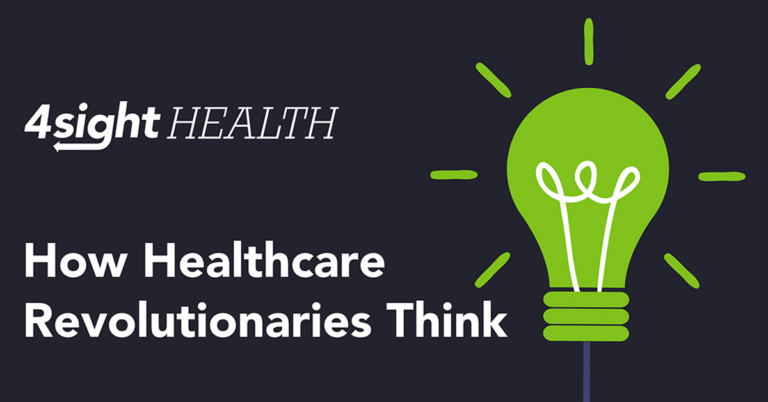April 23, 2020
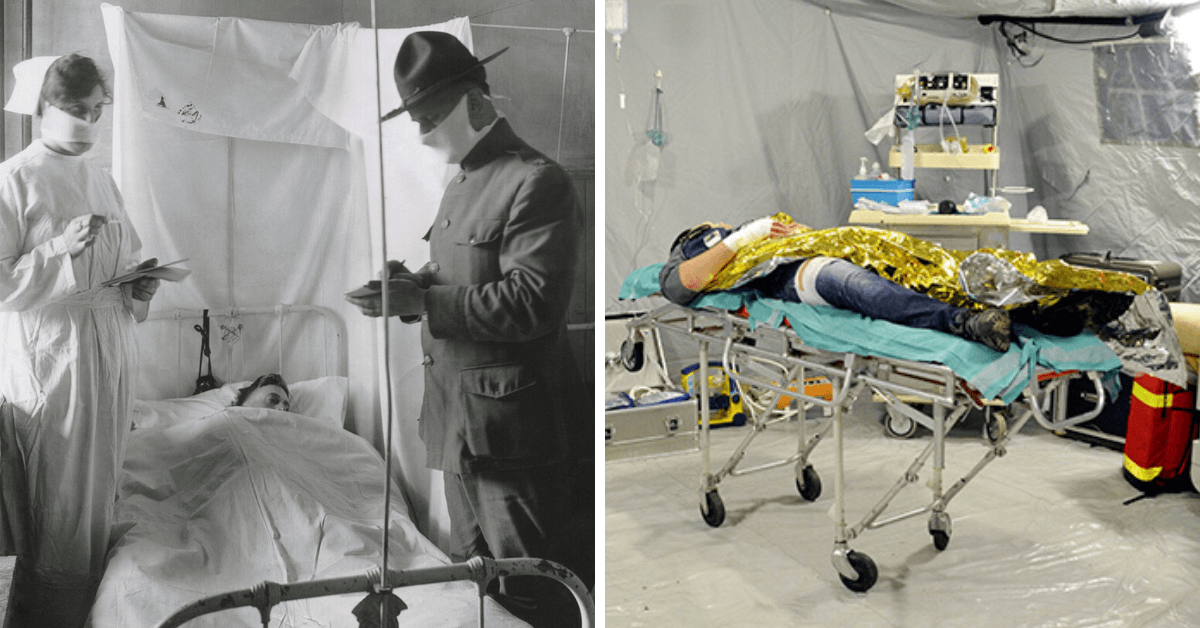
Then and Now: What Woodrow Wilson’s 1918 Pandemic Failure Can Teach Us Today
Key Takeaways:
- There are eerie parallels between the 1918 and current viral pandemics.
- Woodrow Wilson’s decision to pursue the war irrespective of the pandemic accelerated the disease spread and increased its massive death toll.
- Pandemics occur in waves. The second wave in the 1918 pandemic was the most deadly. Other waves will likely occur during the current pandemic.
- Innate optimism, strong libertarian instincts, native distrust of national government, diversity, sectarianism, and partisan division hinder American efforts to fight pandemics.
- Exceptional times call for exceptional measures and exceptional leadership to unite against a common foe.
The distant echoes of the 1918 influenza pandemic have profound relevance for addressing the current COVID-19 pandemic in early 2020. 1918 is the only other time in America’s history that the nation has confronted a pandemic disease. The pandemic hit as the nation was fighting World War I. Then as now, uncertainty, fear, ignorance and wishful thinking governed much individual, community and governmental behaviors.
American exceptionalism led the allies to victory in WW I. It also led the nation to ignore the influenza pandemic and accelerate its spread. Fighting COVID-19 today in the spring of 2020, America is repeating many of the behaviors that it took over a century ago fighting influenza – some good, many bad.
Writer and philosopher George Santayana famously observed that “those who forget the past are condemned to relive it.” To learn from that experience, we need to understand why America’s response to the influenza pandemic unfolded as it did.
A good time and place to begin is October 7, 1918 in the Oval Office.
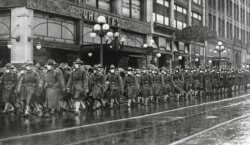
The Guns of October
In the fall of 1918, Woodrow Wilson was a popular wartime president close to winning WW I on his terms. Once victory was in hand, Wilson intended to reshape the world’s nations in America’s progressive and democratic mold.[1]
Wilson’s grand vision collided head-on with a global pandemic that devastated everything in its path. The pandemic and the war were the subject of a pivotal late evening meeting at the White House.
President Wilson had summoned the Army’s Chief of Staff General Peyton March to discuss troop deployments. Troubled by the alarming number of soldiers dying from the flu, Wilson questioned General March’s decision to continue shipping U.S. troops to Europe,
I have had representations sent to me by men whose ability and patriotism are unquestioned that I should stop the shipment of men to France until this epidemic of influenza is under control…You decline to stop those shipments.
In response, March gave a spirited defense of Army’s transfer operations. He enumerated all the steps the Army was taking to protect soldiers. While acknowledging that some soldiers had died in transit, March stressed their deaths were not in vain, “Every such soldier who has died just as surely played his part as his comrade who died in France.”
Wilson allowed the troop transfers to continue unabated. War trumped disease with catastrophic consequences. More American soldiers died from the “Spanish Flu” during World War I than on the battlefield.
Wilson’s single-minded war pursuit accelerated the spread of the deadly influenza. Influenza ultimately killed 675,000 Americans and 50 to 100 million people worldwide in three waves. The influenza was particularly virulent in low-income countries, often killing five to ten percent of their populations.
For an activist president, President Wilson’s passive response to the influenza pandemic is baffling. Singularly focused on winning the war and achieving a just peace, Wilson failed to publicly acknowledge the pandemic, much less address it. His indifference had disastrous consequences.
Woodrow Wilson’s War
World War I began in July 1914 and immediately became a slaughterhouse. The “war to end all wars” killed twenty million soldiers and civilians by the time it ended on November 11, 1918. President Wilson was a reluctant warrior, resisting multiple justifications and appeals to join the conflict. He ran for reelection in 1916 on an anti-war platform, barely winning.
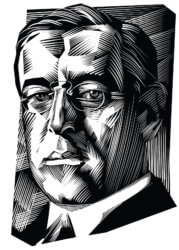 After Congress declared war against the Central Powers in January 1917, the reluctant warrior switched direction. President Wilson put the nation on full war footing. Deeply religious, Wilson believed that “America was born to exemplify that devotion to the elements of righteousness which are derived from the revelations of Holy Scripture.” He summed up his war philosophy as follows,
After Congress declared war against the Central Powers in January 1917, the reluctant warrior switched direction. President Wilson put the nation on full war footing. Deeply religious, Wilson believed that “America was born to exemplify that devotion to the elements of righteousness which are derived from the revelations of Holy Scripture.” He summed up his war philosophy as follows,
To fight you must be brutal and ruthless, and the spirit of ruthless brutality will enter the very fiber of our national life, infecting Congress, the courts, the policeman on the beat, the man in the street.
With uncompromising vigor, Wilson set out to “train the nation” for war. His authoritarian policies got the job done but compromised civil liberties and left his administration blind to the looming pandemic.
During WWI, the federal government essentially ran the economy. It allocated food, fuel and material resources, controlled production, set wages and virtually nationalized the railroads. It launched a massive Liberty Bond campaign to fund the war effort.
Wilson’s administration censored the press, stifled public speech, and jailed dissenters. It created a massive propaganda campaign and enlisted over two hundred thousand citizens in the American Protective League to spy on their neighbors, report food hoarders, identify slackers and push Liberty Bond sales.
Wilson was unrelenting, unapologetic and driven with missionary zeal. He opened a July 1917 Liberty Bond rally in Baltimore with this vehement declaration,
There is, therefore, but one response possible from us: Force, Force to the utmost, Force without stint or limit, the righteous and triumphant force which shall make Right the law of the world and cast away selfish dominion down to the dust.
It took time to mobilize for war. Prior to his war declaration, the U.S had fewer than 500,000 men in uniform. By the end of the war, that number had swelled to 4 million with 2 million serving in Europe.
By the summer of 1918, the nation’s war machine was humming. That spring, Wilson had expanded the draft to include all males from 18 to 45. Approximately 13 million men registered.
The new recruits reported to newly constructed training camps in vast numbers. The camps strained to accommodate them within tight quarters. They soon overflowed well beyond capacity.
The Virus Cometh
The contagious 1918 pathogen was not a novel virus. It was an H1N1 virus that birds transmitted to humans.[2] Recent epidemiological evidence suggests the virus originated in China in 1917.[3] The influenza’s first U.S. manifestation occurred during February 1918 in Haskell County, Kansas. Haskell is located in the state’s remote southwestern corner.
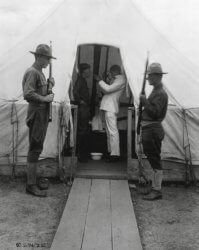
The virus might have died in Haskell, except that newly minted soldiers carried it from there to military training bases, most notably Camp Funston. Constructed just the year before and located three hundred miles east of Haskell, Funston was the nation’s second-largest training facility, hosting an average of 56,000 recruits.
The initial outbreak was small but severe. 237 soldiers contracted the influenza at Funston. Twenty percent required hospitalization and 38 died. The outbreak ended before it garnered much attention. The virus spread to Europe via American soldiers where it mutated, became more deadly and infected large numbers of French and German troops.
A more lethal form of the virus returned to American shores that fall just as the military training camps swelled with new recruits. The camps were an ideal breeding ground for spreading deadly influenza. The experience of Camp Grant, a prototypical training facility, illustrates how the influenza overwhelmed camp operations.
Located in northern Illinois, newly constructed Camp Grant was an orderly place with rows of wooden barracks and barrack tents. Each tent slept 18 men. Recruits came primarily from northern Illinois and Wisconsin. Built for 30,000 troops, Camp Grant’s ranks had swelled to over 40,000 when the first influenza cases presented on September 21st, 1918.
The camp produced its own food and had a 2,000-bed hospital facility. The camp’s medical team followed Army guidelines to quarantine new troops and transfers, but it did little good. The disease spread furiously. Between September 21st and 27th, the hospital census increased from 610 to 4,102 occupied beds.
As the influenza claimed its first victims at the camp, over three thousand Fort Grant soldiers boarded a transfer train to Georgia. Hundreds packed into each poorly ventilated rail car. The influenza thrived in these close quarters. Two-thirds of the traveling soldiers required hospitalization. Ten percent or more died.
Back at Camp Grant, new influenza cases exceeded 1,000 per day and spiraled upward. Soldiers began dying in droves. Deaths per day exceed one hundred for the first time on October 4th. Death was everywhere. On October 8th, the camp’s commander, Colonel Charles Hagadorn, heard the latest death toll, ordered all personnel to leave the building, and then shot himself.
Fort Grant’s experience of disease, misery and death occurred on military facilities throughout America and Europe. It was only a matter of time before the disease spread from military to civilian populations.
Decisions & Consequences
President Wilson never made a public statement regarding influenza. He never inquired about influenza’s impact on the civilian population. Instead, his administration concentrated on boosting national morale. They wanted nothing to distract from the war effort.
War and disease confronted one another in Philadelphia that September. Despite significant evidence that influenza was surging within the city, local leaders decided to proceed with the largest parade in Philadelphia’s history. The purpose was to build public support for the war and raise millions in war funding through the sale of Liberty Bonds.
The massive Liberty Bond parade on Saturday, September 28th turned Philadelphia into a ghost town. In The Great Influenza, John Barry describes the rising death tool and its gruesome consequences,
On October 1, the third day after the parade, the epidemic killed more than one hundred people — 117 — in a single day. That number would double, triple, quadruple, quintuple, sextuple. Soon the daily death toll from influenza alone would exceed the weekly death toll from all causes — all illnesses, all accidents, all criminal acts combined…
Federal, municipal, and state courts closed. Giant placards everywhere warned the public to avoid crowds and use handkerchiefs when sneezing or coughing. Other placards read “Spitting equals death.” People who spat on the street were arrested — sixty in a single day…
But the most terrifying aspect of the epidemic was the piling up of bodies…The city morgue had room for 36 bodies. Two hundred were stacked there. The stench was terrible; doors and windows were thrown open. No more bodies could fit.
The influenza attacks in Philadelphia repeated themselves throughout America. 6.2% of all coal miners and 3.3% of all industrial workers insured by Metropolitan Life died from the viral disease.
President Wilson himself suffered a debilitating case of influenza in April 1919 during marathon peace negotiations in Paris. Weakened by the disease, Wilson agreed to French demands for punishing reparations payments and territorial concessions in exchange for a “league of nations” to settle international disputes.
The harsh peace accord set Germany on a path to hyperinflation, chaos, nationalism, militarization and war. Some speculate that Wilson’s influenza was a causal factor for the massive stroke he suffered in October 1919. That stroke incapacitated him for the remainder of his presidency. As he recuperated, Wilson’s treasured League of Nations failed to receive Congressional approval and faltered.
It took until the 1930s for American and British researchers to isolate the viral causes of the 1918 pandemic. While there have been several viral outbreaks since, none has had the global reach and impact of the 1918 influenza. Until now.
Then & Now
Although they share similar symptoms, COVID-19 is not influenza, but a type of highly contagious viral pneumonia.[4] This is why existing influenza vaccines are ineffective against the coronavirus. Like the 1918 influenza, COVID-19 is a lethal respiratory disease with no known cures or preventive vaccines.
The 1918 influenza attack surprised and paralyzed America in much the same way that COVID-19 has today. Moreover, the nation’s responses to influenza in 1918 and COVID-19 today are eerily similar. There are numerous parallels between then and now in how America has experienced, characterized and sought to contain these contagions.
Viral diseases emerge and spread methodically as their pathogens jump indiscriminately to new hosts/victims. While America and Europe slept, the coronavirus came to life in China during November 2019 and spread to nearby Asian countries. More familiar with viral contagions, these countries locked down their citizens and slowed the coronavirus’ spread.
Despite these aggressive containment efforts, COVID-19 broke out of Asia in January and spread west. Both America and Europe were caught flat-footed and ill-prepared to address the outbreak. The U.S. has become the epicenter for the disease with multiple hot spots, widespread infection and mounting deaths.
Parallels between the 1918 Influenza and COVID-19
- The vast majority of disease victims recovered quickly and fully.
- Those spreading the disease were often asymptomatic.
- The disease struck in a rising power (the U.S. in 1918; China today).
- Governments were slow to respond to the disease spread.
- The news media underreported the diseases in their early stages.
- Scientific, evidence-based information competed with speculation, rumor and inuendo.
- Quarantines increased isolation and kept loved ones away from patients.
- Government leaders seeking to allay fears understated the disease threat.
- Government inaccuracies, lies and mismanagement diminished public trust.
- Lack of intergovernmental coordination created confusion.
- Governmental focus on non-disease issues (war, the economy) impeded responsiveness.
- State and local governments pursued disease management with varying effectiveness.
- Healthcare workers, often heroic, disproportionately contracted the disease.
- Citizens often blamed others (the Germans, Chinese) for the disease spread.
- Exploiting the public’s fear, widespread scams emerged.
- Officials and doctors pursued immediately available but unproven cures.
- Governments and industry undertook massive efforts to create vaccines and cures.
Democracy and Crisis Management
People crave certainty and predictability where there is none. They are often willing to forgo their civil liberties for safety and protection. Woodrow Wilson took advantage of this basic human instinct in mobilizing the nation to fight in World War I. Imagine if he’d employed the same determination in combatting the influenza outbreak.

Dealing with the COVID-19 pandemic in spring 2020, some countries (notably China) have employed fear, forced quarantines and aggressive policing to enforce social distancing. Authoritarianism, however, has its limitations. It’s much better to engage willing volunteers than direct fearful masses.
Creating physical distancing is a more nuanced exercise in the United States. Leaders confront the difficult task of policing public behavior while building public support. It requires exceptional leadership and execution skills to manage this delicate balancing act.
Effective crisis management incorporates the following framework and capabilities:
- State and local control of regional crisis response efforts
- Federal support for local efforts
- Federal control of regional responses when local responses are inadequate
- Coordination of local, state and governmental efforts supported by data
- Clear, honest and trustworthy communication
In extreme cases such as this COVID-19 pandemic, the federal government should appoint a leader to coordinate the national response. President Wilson assumed this role for himself during WWI but focused on the war instead of the pandemic.
There is no light yet at the end of the COVID-19 tunnel. It will likely be a long, painful journey from here to the end of the crisis. The Singapore experience illustrates the dimensions of pandemic peril.
Singapore arguably orchestrated the most effective initial response to contain COVID-19. Their success in halting the disease spread enabled the country to avoid lockdown until April 2020. By then, a large number of new COVID-19 cases had emerged and led the government to institute societal lockdown. There’s every reason to believe that this same rolling pattern of COVID-19 suppression and outbreaks will occur here in the United States.
American Exceptionalism
Even in the best of times, America has difficulty uniting to confront a common foe. Innate optimism, strong libertarian instincts, native distrust of national government, diversity, sectarianism, and partisan division are woven into the fabric of the nation’s DNA. When united, however, Americans achieve exceptional results.
President Wilson understood America’s exceptionalism and its potential to change the course of World War I. This is why Wilson took such aggressive measures to unite the nation in support of the war effort.
Unfortunately, President Wilson lacked the information, context and understanding to realize that the pandemic threatened far more American lives than the war. While tragic, Wilson’s decisions are understandable within the context of his times.
Today’s federal, state and local leaders have no such justification. They must and are mobilizing to prevent the disease spread and consider strategies for reopening American society.
Until there are vaccines and cures, the only force strong enough now to counter COVID-19 is positive social contagion (e.g. physical distancing, handwashing, wearing masks, etc.). These vital tactics limit the virus’ ability to jump to new hosts. Along with massive testing, these tactics will enable American society to reopen over time by locale.
Prominent leaders are rising to the challenge. Governors Gavin Newsom of California and Larry Hogan of Maryland, have acted quickly to slow the disease spread, built surge capacity to treat the afflicted. They have earned the trust and confidence of their states’ citizens through clear communication, on-the-ground action and by creating a sense of shared sacrifice.
An unpredictable and lethal virus caused this crisis. Leadership will overcome it. Exceptional times call for an exceptional people to achieve exceptional results.
Sources
- The primary source for this article is The Great Influenza by John Barry and published by Viking in 2004
- https://www.cdc.gov/flu/pandemic-resources/1918-commemoration/1918-pandemic-history.htm
- https://www.nationalgeographic.com/news/2014/1/140123-spanish-flu-1918-china-origins-pandemic-science-health/#close
- https://www.biospace.com/article/2009-h1n1-pandemic-versus-the-2020-coronavirus-pandemic/



